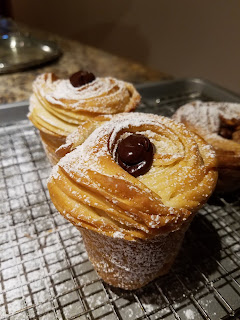Before Desert
Panne all'Olive (Olive Bread)
Reprinted from My Bread: The Revolutionary No-Knead, No-Work Method by Jim Lahey. Copyright © 2009 Published by W.W. Norton & Co.
When I first opened Sullivan Street, with Roman baking in mind, this slightly pungent olive loaf immediately became my signature bread. As a result of the brine the olives release during baking, this recipe calls for no salt.
Ingredients
- 3 cups bread flour (400 grams)
- About 1 1/2 cups roughly chopped pitted olives (200 grams, see note)
- 3/4 teaspoon instant or other active dry yeast (3 grams)
- 1 1/2 cups cool (55 to 65 degrees F) water (300 grams)
- wheat bran, cornmeal, or additional flour for dustingb
Instructions
1. In a medium bowl, stir together the flour, olives, and yeast. Add the water and, using a wooden spoon or your hand, mix until you have a wet, sticky dough, about 30 seconds. Cover the bowl and let sit at room temperature until the surface is dotted with bubbles and the dough is more than doubled in size, 12 to 18 hours.
2. When the first rise is complete, generously dust a work surface with flour. Use a bowl scraper or rubber spatula to scrape the dough out of the bowl in one piece. Using lightly floured hands or a bowl scraper or spatula, lift the edges of the dough in toward the center. Nudge and tuck in the edges of the dough to make it round.
3. Place a tea towel on your work surface and generously dust it with wheat bran, cornmeal, or flour. Gently place the dough on the towel, seam side down. If the dough is tacky, dust the top lightly with wheat bran, cornmeal, or flour. Fold the ends of the tea towel loosely over the dough to cover it and place it in a warm, draft-free spot to rise for 1 to 2 hours. The dough is ready when it is almost doubled. If you gently poke it with your finger, it should hold the impression. If it springs back, let it rise for another 15 minutes.
4. Half an hour before the end of the second rise, preheat the oven to 475 degrees F, with a rack in the lower third, and place a covered 4 1/2 - to 5 1/2 -quart heavy pot in the center of the rack.
5. Using pot holders, carefully remove the preheated pot from the oven and uncover it. Unfold the tea towel and quickly but gently invert the dough into the pot, seam side up. (Use cautionóthe pot will be very hot; see photos, page 55.) Cover the pot and bake for 30 minutes.
6. Remove the lid and continue baking until the bread is a deep chestnut color but not burnt, 15 to 30 minutes more. Use a heatproof spatula or pot holders to gently lift the bread out of the pot and place it on a rack to cool thoroughly.
NOTE: For this loaf, any pitted olive will yield something worth eating. (You don't want to go to the trouble of pitting them yourself, because it is tedious and the results will not be as neat.) But what I turn to most often are pitted kalamata olives soaked in a pure salt brineónothing else, just salt. A commonly available kalamata that I'm very fond of is made by Divina and can be found at many supermarkets and gourmet stores. You might think that because they're black they will change the color of the bread, but they won't, unless you carelessly dump some of the brine into the dough. Green Sicilian colossals, sometimes called "giant" olives, packed in pure salt brine, are another good option; they're often available at Italian food stores.

Comments
Post a Comment
Comments are moderated to prevent spam. May take a while to see them posted.